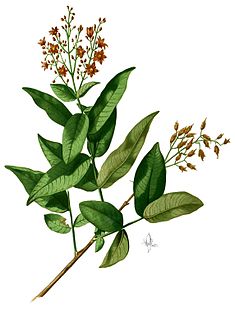
Vallaris is a genus of plants in the family Apocynaceae first described as a genus in 1768. It is native to China, the Indian Subcontinent, and Southeast Asia.
- Vallaris anceps = Kibatalia macrophylla
- Vallaris angustifolia = Kibatalia gitingensis
- Vallaris arborea = Kibatalia macrophylla
- Vallaris clavata = Echites clavatus
- Vallaris daronensis = Kibatalia maingayi
- Vallaris divaricata = Strophanthus divaricatus
- Vallaris fimbriata = Euphorbia mammillaris
- Vallaris gitingensis = Kibatalia gitingensis
- Vallaris ipecacuanhae = Euphorbia ipecacuanhae
- Vallaris lancifolia = Vallariopsis lancifolia
- Vallaris laxiflora = Pottsia laxiflora
- Vallaris macrantha = Beaumontia macrantha
- Vallaris maingayi = Kibatalia maingayi
- Vallaris missurica = Euphorbia missurica
- Vallaris portulacoides = Euphorbia portulacoides
- Vallaris × uniflora = Euphorbia × uniflora

Cratoxylum is a genus of flowering plants in the family Hypericaceae, native to tropical Asia. The generic name is from the Greek meaning "strong wood", referring to the timber.

Stephanotis is a genus of flowering plants first described in 1806. The name derives from the Greek stephanōtís fit for a crown, derivative of stéphanos (masculine) crown. It contains evergreen, woody-stemmed lianas with a scattered distribution in several tropical and subtropical regions.

Byttneria is a genus of flowering plants in the family Malvaceae. There are about 135 species in this pantropical genus.

Alphonsea is a genus of plant in the family Annonaceae. As of April 2014 The Plant List recognises 38 accepted species:

Scleropyrum is a genus of trees in family Santalaceae first described as a genus in 1838. At present, only one species is recognized, although several others are listed as "unresolved," meaning that further research is needed to determine affinities.
Swintonia is a genus of plants in the family Anacardiaceae.
Gonystylus maingayi is a tree in the family Thymelaeaceae.

Machaerina (twigrush) is a genus of flowering plants in the sedge family. Its species occur in tropical America, the West Indies, Malesia, Australia and the Pacific region. The name comes from the Greek machaira, alluding to the shape of the leaves in the type species – Machaerina restioides.
Pothos lancifolius is climbing plant species described by Hooker in the family Araceae. No subspecies are listed in the Catalogue of Life. This species has been recorded from Peninsular Malaysia and Vietnam - where it is called ráy leo lá rách or ráy leo hình bút lông.
Garcinia nigrolineata has been called "wild beaked Kandis" and is a tree species in the family Clusiaceae. The Catalogue of Life lists no subspecies.

Phlogacanthus is a genus of flowering plants in the family Acanthaceae and tribe Andrographideae. Its distribution includes India through to Indo-China, southern China and Sulawesi.
Fibraurea is a plant genus in the family Menispermaceae.

Wrightia religiosa is a species of tree in the family Apocynaceae. Its distribution includes: China (Guangdong), Indochina and Malesia including the Philippines; no subspecies are listed in the Catalogue of Life.
Swintonia pierrei is a tree species in the family Anacardiaceae. It is native to Cambodia and Vietnam.

Swintonia floribunda is a tree species in the family Anacardiaceae. It can be found in the Andaman Islands, Indo-China and Malesia through to Sumatra.
Parishia is an Asian plant genus in the family Anacardiaceae, subfamily Anacardioideae. It is found in Indo-China and Malesia; no subspecies are listed in the Catalogue of Life.

Mitrephora maingayi is a species of plant in the family Annonaceae. It is native to Bangladesh, Borneo, Cambodia, Laos, Peninsular Malaysia, Myanmar, Sumatra, and Vietnam. Joseph Hooker and Thomas Thomson, the British botanists who first formally described the species, named it in honor of Alexander Carroll Maingay, the British botanist who collected the specimen they examined.
Disepalum is a genus of plants in the family Annonaceae and tribe Annoneae.
Aframomum cereum is a monocotyledonous plant species in the family Zingiberaceae that was first described by Joseph Dalton Hooker, and got its current name from Karl Moritz Schumann.










